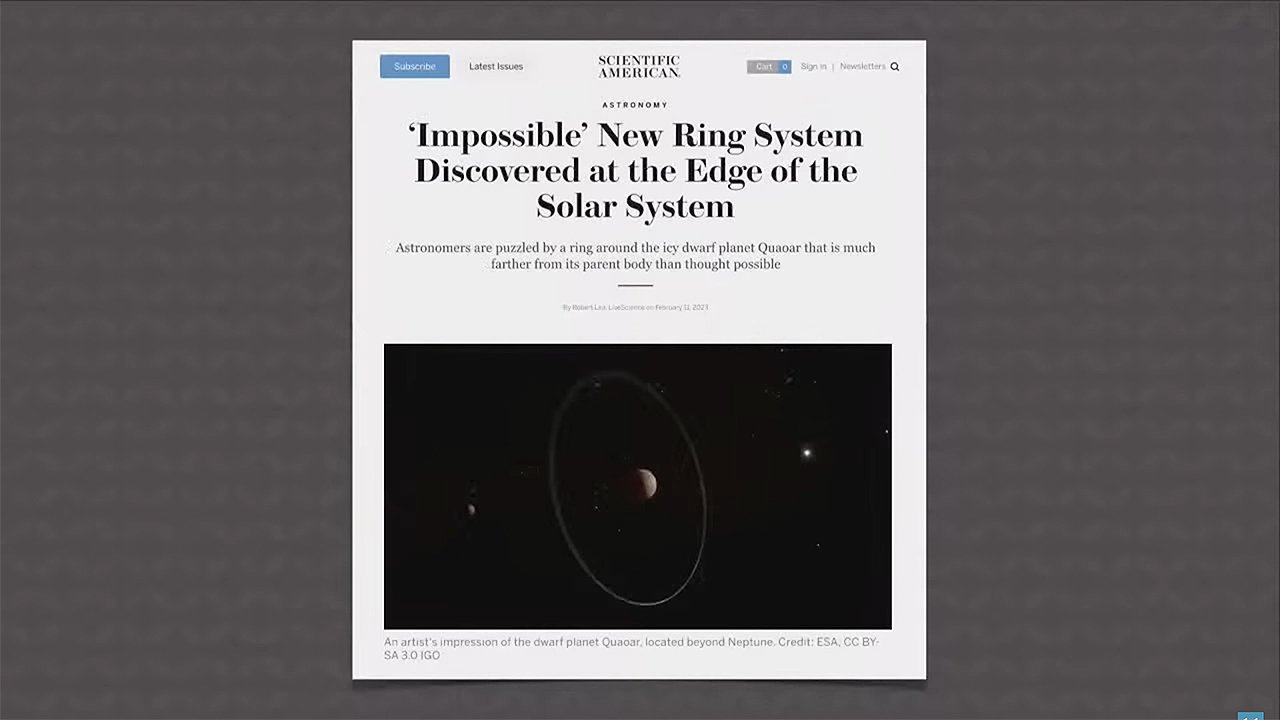
It’s Time to Rewrite Another Evolutionary Theory
Planetary rings, like those encircling Saturn or Jupiter, are a beautiful feature of the heavens. And a brand-new ring system was recently discovered, wrapping around Quaoar, a dwarf planet half the size of Pluto and located past Neptune. This brings the number of ringed objects in our solar system to seven. And—like the rings surrounding Saturn—this planet’s rings are also a challenge to what’s referred to by evolutionists as “ring formation theories.”
The rings of Quaoar don’t follow the “rules” of the evolutionary paradigm!
According to evolutionists, planetary rings formed when “collisions of moonlets orbiting the parent planet created debris that settled into a ring made of rock, ice and dust particles.” But it’s thought that tidal forces created by the planet determine how far away from the planet rings can form. But the rings of Quaoar don’t follow the “rules” of the evolutionary paradigm!
A co-author on a paper describing these new rings states,
The six [previously known] planets with ring systems all have rings which are quite close to the surface of the planet. So this really challenges our ring formation theories…It was previously thought to be impossible to have rings that far out, so in a nutshell, the ring of Quaoar is a real challenge to explain theoretically.
These rings are located “twice as far out as the theoretical maximum limit for a ring system” (that limit is known as the Roche limit) which is a problem for the evolutionary model,
Rings that are formed outside Roche limits aren't meant to be stable; they should rapidly accrete into moonlets, using up all the ring material. . . . With this discovery, we have a ring not just outside the Roche limit, but way beyond it.
Now the scientists are looking into possibilities for why Quaoar’s rings are the way they are—but I actually already have the big-picture answer! And it’s a two-fold answer:
- Planetary rings didn’t form through chance, random processes! Planets, in all their splendor and diversity, were created by God on day four of creation week. So while we can study rings to learn details about their composition and other features, we don’t need to study them to find out how or when they were made—God has already told us that! He designed them.
- Planets, and by extension their rings, are only thousands of years old! We don’t have to wonder how their rings could exist for millions of years because every planet only dates back about 6,000 years.
Evolutionary ideas for how everything formed—from planets to stars to all of life—will need constant revision and updating because evolutionists have the wrong starting point of man’s ideas rather than the perfect, infallible Word of God that gives us the true history we need to understand the world around us. And that’s why evolutionists have to keep changing their ideas as more evidence (contradictory evidence) keeps coming.
Get More Answers on Answers News
This item was discussed Wednesday on Answers News with cohosts Rob Webb, Patricia Engler, and Jessica Jaworski. Answers News is our weekly news program filmed live before a studio audience here at the Creation Museum and broadcast on my Facebook page and the Answers in Genesis Facebook page. We also covered the following topics:
- Mass suicide of the elderly?
- Is a “Surprising Work of God” happening at Asbury?
- Whistleblower: “gender-affirming care” is destroying kids.
- And more!
Watch the entire episode of Answers News for February 22, 2023.
Be sure to join us each Wednesday at 2 p.m. (ET) on my Facebook page or the Answers in Genesis Facebook page for Answers News. You won’t want to miss this unique news program that gives science and culture news from a distinctly biblical and Christian perspective.
Thanks for stopping by and thanks for praying,
Ken
This item was written with the assistance of AiG’s research team.
Most Recent News
-
Dec. 18, 2025 from Ken Ham Blog
New data suggests IVF embryo deaths now exceed abortion totals, meaning abortion is no longer the leading cause of death in the US.
-
Dec. 15, 2025 from Ken Ham Blog
Are tomatoes “de-evolving” on the remote Galápagos islands?

Answers in Genesis is an apologetics ministry, dedicated to helping Christians defend their faith and proclaim the good news of Jesus Christ.
- Customer Service 800.778.3390
- Available Monday–Friday | 9 AM–5 PM ET
- © 2025 Answers in Genesis



